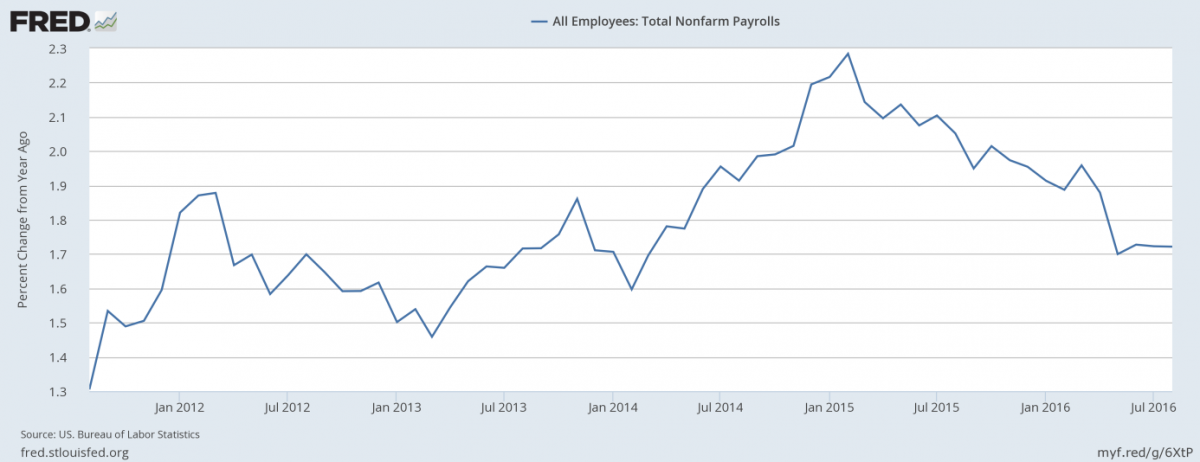Disappointing August Payrolls And Gold

 The US economy added 151,000 jobs in August. What does it imply for the Fed policy and the gold market?
The US economy added 151,000 jobs in August. What does it imply for the Fed policy and the gold market?
Surprising Weakness
Total nonfarm payroll employment rose only by 151,000, according to the U.S. Bureau of Labor Statistics. Analysts expected 175,000 jobs created. Thus, the actual number was a negative surprise, after a strong July report. The revisions were small: the revised employment gains for May and June were 1,000 less than previously reported. It implies that job gains in the last three months have averaged 232,000. Job gains were concentrated in service-providing industries, such as education, health care, leisure and hospitability or professional and business services. Mining, manufacturing, construction and utilities reduced jobs.
The report indicates that the pace of hiring in the U.S. slowed sharply in August after huge gains earlier in the summer. The chart below shows that the last report is a continuation of a downward trend in job gains (on an annual basis) which started in February 2015.
Chart 1: Total nonfarm payrolls (percent change from year ago) over the last five years.
Other Labor Market Indicators
Other labor market indicators were hardly changed. The unemployment rate was unchanged at 4.9 percent. Also both the labor force participation rate, at 62.8 percent, and the employment-population ratio, at 59.7 percent, remained unchanged for a second month in a row. However, the average workweek decreased by 0.1 hour to 34.3 hours, while the average wage rose 0.3 cents to $25.73. On an annual basis, an hourly pay increased 2.4 percent, indicating some upward wage pressure. The jump in wages should be welcomed by the FOMC members, in contrast to a reduced workweek.
August Payrolls And Gold
The disappointing report is positive for the gold market. The payrolls were not a disaster, but were significantly below expectations and may incline the Fed to wait in September. As we wrote on Friday, “job gains below 190,000 or 177,000 may disappoint markets and postpone a tightening until after presidential elections”. Indeed, the price of the shiny metal jumped around $15 to $1,330 after the release of the employment report. The market odds of a Fed hike rate in September declined from 24 to 21 percent, according to the CME Group’s FedWatch tool. And the odds of a December move decreased from 53.6 to 50.6 percent. Although the change was not radical, the expected path of the federal funds rate flattened, which pushed the price of gold up.
In other words, the weak data makes the Fed hike in September unlikely, as the FOMC members will probably wait to see if there is a bounce back in hiring before raising interest rates. It means that gold may catch its breath and escape the downward pressure started after Yellen’s hawkish speech in Jackson Hole. However, investors should not neglect two things. First, technically, the yellow metal failed to break a resistance at $1,330. Second, fundamentally, job gains have averaged 232,000 per month over the past 3 months. It is much more that the previous three-month average of 190,000 cited by Yellen as an indication of a strong labor market. And other labor market reports, such as weekly jobless claims and job openings, suggest that the labor market remains strong. Looking from such a perspective, the labor market remains solid, and the Fed may turn out to be more hawkish than expected. Moreover, August is always a wild card and preliminary estimates for August often undershoot the actual number of jobs created. Having said that, we still do not see a rate hike until after the elections. Now, the crucial factor for the dynamics of the price of gold may be the Fed officials’ comments about the weak employment report.
Disclaimer: Please note that the aim of the above analysis is to discuss the likely long-term impact of the featured phenomenon on the price of gold and this analysis does not indicate (nor does it aim to do so) whether gold is likely to move higher or lower in the short- or medium term. In order to determine the latter, many additional factors need to be considered (i.e. sentiment, chart patterns, cycles, indicators, ratios, self-similar patterns and more) and we are taking them into account (and discussing the short- and medium-term outlook) in our trading alerts.



















